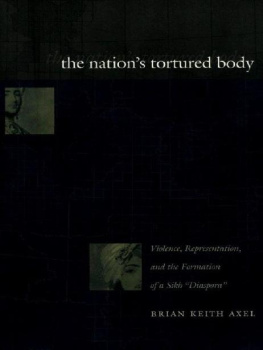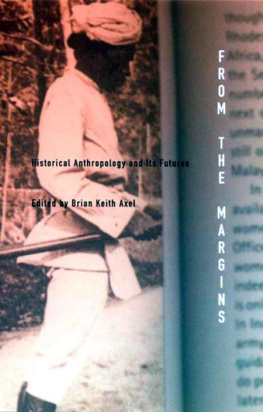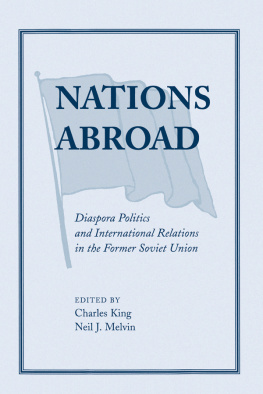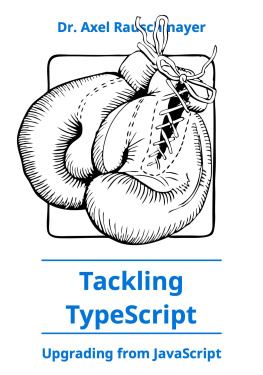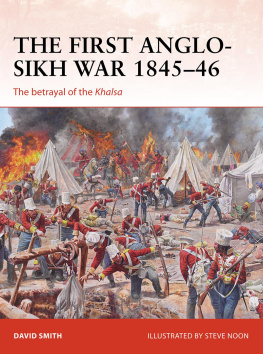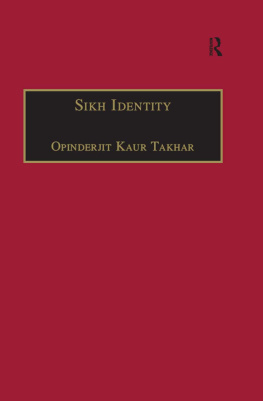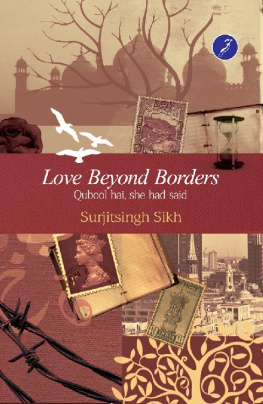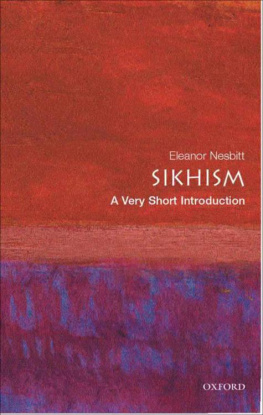the nations tortured body
the nations tortured body
Violence, Representation, and the Formation of a Sikh Diaspora
Brian Keith Axel
Duke University Press
Durham and London
2001
2001 Duke University Press
All rights reserved
Printed in the United States of America on acid-free paper
Typeset in Carter & Cone Galliard by Keystone Typesetting, Inc.
Library of Congress Cataloging-in-Publication Data appear on the last printed page of this book.
Contents
list of figures
acknowledgments
Many people have helped me throughout the years that I have been researching and writing about the Sikh diaspora. I must express the greatest debt to Arjun Appadurai, Bernard Cohn, Jean Comaroff, Homi Bhabha, Lauren Berlant, and Elizabeth Povinelli at the University of Chicago, who have read through several drafts of my work and provided me with persistent challenges to write and think more creatively and clearly. Others at the University of Chicago have also contributed to this process: Andrew Apter, Carol Breckenridge, John Comaroff, Dipesh Chakrabarty, Ronald Inden, McKim Marriott, Nancy Munn, Moishe Postone, Marshall Sahlins, Saskia Sassen, and Terry Turner. I must also thank the University of Chicagos Anne Chien, who has given me far more help than I deserved. Paul Silversteinfirst in Chicago, then in London, Paris, New York, and elsewherehas been a dear friend, a persistent critic, and an enduring interlocutor.
My first teachers of anthropology at the University of Texas must be acknowledged for the spirit of inquiry that they introduced to me: James Brow, Steven Feld, and Ward Keeler. Their imprint on this text may be recognizable at least by the fact that it has been written and also by its resistance to offering easy answers. Likewise, I wish to mention Christopher Pinney who, beyond the call of duty, offered an institutional home for me at so as in London, read through and encouraged the writing of early drafts of work, and shared the joy of dialogue and debate. Ken Wissoker at Duke University Press has been a persistent and patient source of encouragement, and I thank him for having confidence in this project.
In India, England, and North America, I have met with great friendships and mentorships. There are too many people to mention here, but I should make special note of Nikky Singh (Colby College), who first introduced me to the study of Sikhism; the late Harbans Singh (of Patiala); Virendra Singh (of Varanasi); W. H. McLeod; Thomas Morrione (Colby College); Mohinder Singh (director of the Bhai Vir Singh Sahitya Sadan, New Delhi); GeraldBarrier (University of Missouri-Columbia); Nicholas Dirks (Columbia University); Debbora Battaglia (Mt. Holyoke College); Verne Dusenbery (Hamline University); Arthur Helweg (Western Michigan University); Darshan Singh Tatla (Warwick); Gurharpal Singh (Hull University); Shinder Thandi (Coventry University); Pashaura Singh (University of Michigan) ; and Harjot Singh Oberoi (University of British Columbia). Cynthia Kepley Mahmood (University of Maine, Orono) has offered a courageous precedent. I also thank the archivists who assisted me, especially in New Delhi (the Parliamentary Library, the National Archives, and Bhai Vir Singh Sahitya Sadan), London (the India Office, the National Portrait Gallery, and the British Museum), and Oxford (the Bodleian Library). And I cannot express my gratitude enough to the many other Sikh women and men who have so willingly shared their lives with me. I owe a special thank you to Gyani Karamjit Singhwherever he may bewho, as a friend and teacher, guided me through my first study of Sikhs.
Funding for the research was provided by the National Science Foundation, the MacArthur Foundation (Council for Advanced Studies on Peace and International Cooperation), Fulbright-Hays, a University of Texas Meyerson Fellowship, and a University of Chicago William Rainey Harper Fellowship. I have been substantially aided in revising this book while at Emory University as an Andrew W Mellon Postdoctoral Faculty Fellow in Ethnography and Historiography. My colleagues at Emoryin the Departments of Anthropology, History, and Asian Studies and the Graduate Institute of Liberal Artshave provided me with invaluable dialogue: Bobby Paul, Peter Brown, Paul Courtright, Angelika Bammer, Edna Bay, Ellen Schattschneider, Kristin Mann, Randy Packard, Don Donham, Debra Spitulnik, Ivan Karp, Bruce Knauft, and Brad Shore. My students have often offered the most forthright critique and challenge: Jennifer Bagley, Whitney Cook, Romi Singh Dhillon, Blake Eno, Jeremy Hendon, Matthew Sultan, and Karla Waller. The greatest support and inspiration for this work was provided by my family and friends: Nathalie Loveless Axel, Kenneth Axel, Mary Mandis (Axel), Donna Kori Axel, Robert Axel, Richard Axel, George McCauley, Candice Rev Breitz, Matthew Byram Burke, Filipa, Garreth Burr, Jessica Funk, Lainey Gerber, Tyler Craig Gore, Bill Hamilton, Varinder S. Kalra, Raninder Kaur, M. Whitney Kelting, Marilou Knight, Sadie Korn, Evelyne Lord, Robert Loveless, Stephanie Loveless, Sangeeta Luthra, Bill Morrow, Adam Picard, David Rosen, Steve Runge, Curtis Russet, Beth Russet, Shamus Russet, Tiff (wherever you are), Melissa Watson, and Becky Williams. Acknowledgments notwithstanding, I take sole responsibility for the contents of this inquiry.
This book is dedicated to two dear people who have lived in and through its writing: my father, Kenneth Axel, who left the world on December 22, 1990, and Nathalie Loveless Axel, my wife, who entered into my life on July 27, 1996.
introduction: promise and threat
What is found at the historical beginning of things is not the inviolable identity of their origin; it is the dissension of other things.
Michel Foucault, Nietzsche, Genealogy, History
There is something peculiar and powerful about diasporas today. Perhaps, at least at first glance, this is because it is so difficult to comprehend a site of belonging and identification that is both spectacularly global and preeminently local. Yet who would deny that there is a Jewish diaspora, or a Chinese diaspora, or a Sikh diaspora? One would be hard put to say that, preferring the local to the global, there are no diasporas, rather Chinese in New York or, for example, Sikhs in London. The exemplary quality of these different populations, however, is, precisely, an indication of what makes diasporas peculiar and powerful. What is it about the lifestyle of a certain people that transforms them into an example of a diaspora (i.e., one in a series of something more generally encompassing) ? Or, to turn this around, why is it that people identified as members of diasporas are so often susceptible to the procedures of nation-states that aim at making an example of them (e.g., through immigration legislation, debates over multiculturalism, or cases of deportation)?
These questions offer a challenge, which I take up in this book, to recon-ceptualize the formation of peoplehood through an inquiry into conditions of diaspora, belonging, and violence from colonialism to postcoloniality. In the specific instance, I examine the histories of displacement, of changing homelands, and of corporeality that have grounded the formation of a Sikh diaspora. As of this writing, in 1999, there are an estimated 20 million Sikhs living in the world. Although recent reports vary, it is estimated that 17 million Sikhs live in India and that 3 million are living in and moving between North America, South America, Africa, East and Southeast Asia, Australia, New Zealand, and Europe. By far, the majority of Sikhs outside India are located in Britain and the United States, with the largest concentration (approximately 500,000) in England.
The story that I tell of this dispersed population must be distinguished from the well-known stories of other Indian diasporas. These stories usually begin with the colonial system of indenture, which, in a wide variety of cases, is understood to be the primary factor in the mobilization and dispersal of particular groups of people away from India (e.g., Ballard 1994; Chandan 1986; Kelly 1991; Ram 1989; Shankar and Srikanth 1998; Tinker 1976; and van der Veer 1995). This book, however, does not begin with indenture. The different beginnings of this book, rather, emerge out of three aspects of the histories of displacement constitutive of the Sikh diaspora: first is the position of Sikhs just prior to colonial rule within a unique territory; second is the specific manner of mobility within and after the colonial period; and third is the emergence of transnational struggle to create a separate, sovereign Sikh state called Khalistan. In the following pages, I summarize these three points of emergence, which are then discussed at length throughout subsequent chapters.

